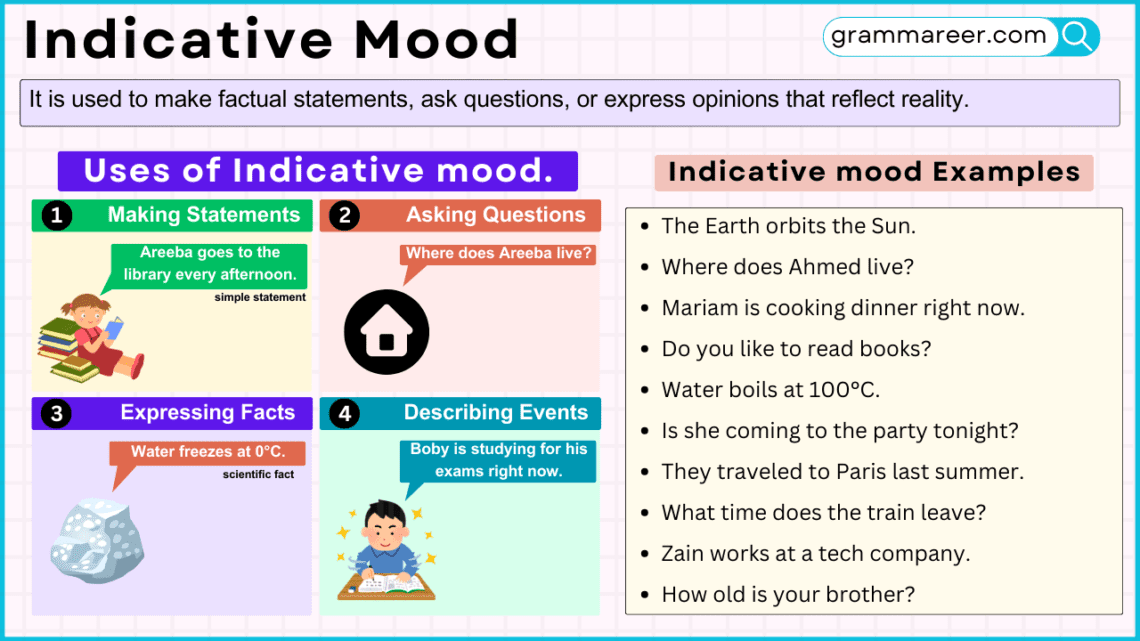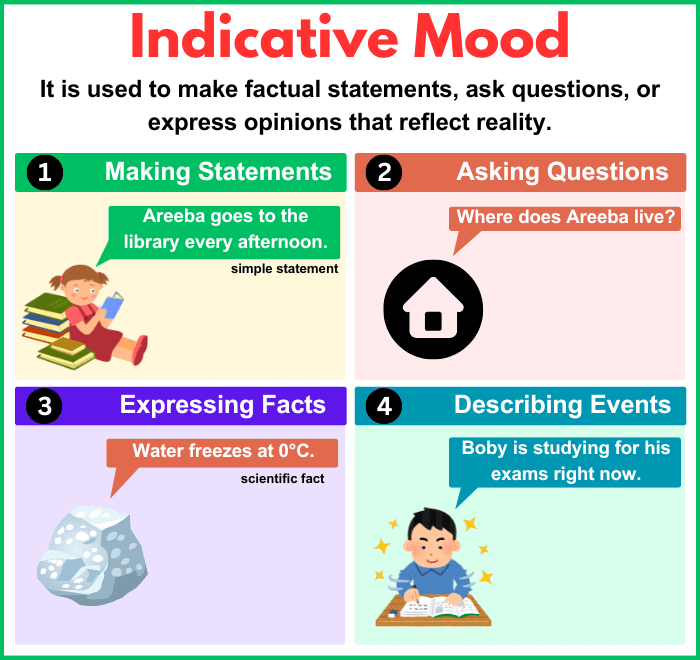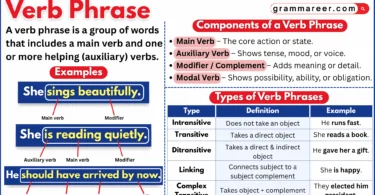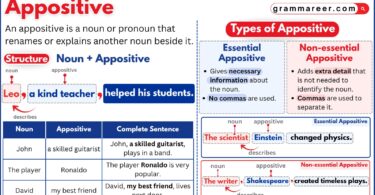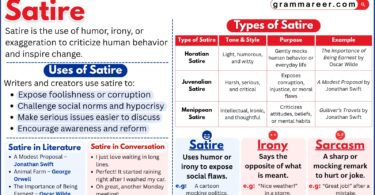The indicative mood is one of the key elements of English grammar, essential for constructing clear and direct statements. It is used to express facts, ask questions, or describe events that are real and happening. By understanding the indicative mood, learners can communicate more effectively in everyday conversations and writing.
It is used to make factual statements, ask questions, or express opinions that reflect reality.
Table of Contents
Examples of Indicative Mood
Here are some examples that present facts, question and are describing events:
- Imam Ali is a respected leader in Islamic history.
- The sky is clear today.
- Rashid works at a local bakery.
- Where does Areeba live?
- Does Yassir have a car?
- How old is Areeba?
- Water boils at 100°C.
- The earth orbits around the sun.
- Fatima speaks three languages.
- Omar is going to the market today.
- We visited the museum yesterday.
- They will arrive at the airport tomorrow.
Uses of Indicative Mood
Here are some different functions with explanation:
1. Making Statements
The indicative mood is used to make factual statements about real events, people, or things.
- Imam Ali is a respected leader in Islamic history.
- The sky is clear today.
- Rashid works at a local bakery.
2. Asking Questions
The indicative mood is used to ask question or inquire about facts or real situations.
- Where does Areeba live?
- Does Yassir have a car?
3. Expressing Facts
The indicative mood is used to express things that are true or factual.
- Water boils at 100°C.
- The earth orbits around the sun.
- Fatima speaks three languages.
4. Describing Events
In English Grammar, People can used to describe events that are happening, have happened, or will happen.
- Omar is going to the market today.
- We visited the museum yesterday.
- They will arrive at the airport tomorrow.
Difference Between Indicative and Other Moods
The indicative mood is used to express facts, asking questions, or describing real actions and events. Other moods, like the imperative and subjunctive, serve different purposes:
Indicative vs. Imperative Mood
The imperative mood is used to give commands, requests, or instructions. Unlike the indicative, it does not provide factual information. Below is a comparison table with clear examples:
| Indicative Mood | Imperative Mood |
|---|---|
| Ali goes to the gym every day. (statement) | Go to the gym! (command) |
| Do you like coffee? (question) | Please sit down. (request) |
| I am feeling tired. (statement) | Write the letter! (instruction) |
| Mariam studies for her exams every night. (statement) | Study hard for the exams! (advice) |
| The children are playing in the park. (statement) | Stop playing in the street! (command) |
| Does Yusuf enjoy his new job? (question) | Bring me that book. (instruction) |
| The food tastes delicious. (statement) | Taste this dish. (request) |
Indicative vs. Subjunctive Mood
We use the subjunctive mood to express wishes, hypothetical situations, or actions that are not yet real. Speakers often use it after certain verbs or expressions of necessity, desire, or doubt. Below is a comparison of the indicative and subjunctive moods:
| Indicative Mood | Subjunctive Mood |
|---|---|
| I know she is coming tomorrow. (statement) | I wish she were coming tomorrow. (wish) |
| It is raining outside. (fact) | If it were raining, we would stay inside. (hypothetical) |
| He always arrives on time. (fact) | It is necessary that he be on time. (necessity) |
| Ahmed enjoys his work. (statement) | If Ahmed were happier, he might stay longer. (hypothetical) |
| The house looks clean. (fact) | I suggest that the house be cleaned. (necessity) |
| Zain is learning to drive. (fact) | If Zain were a better driver, he would pass. (hypothetical) |
| Aisha loves reading novels. (statement) | It is crucial that Aisha read this book. (necessity) |
In the indicative mood, actions are presented as real or factual. In the subjunctive mood, actions are not certain or are wished for, making it less direct and more conditional.
Why Indicative Mood Is Important
Understanding the indicative mood is essential for clear communication. It is the foundation of most everyday language use, allowing speakers to express facts, ask questions, and describe events directly. Without it, language would lose its ability to convey clear, factual information.
FAQs
A verb form that makes statements, ask questions, or describe real actions.
Where does Areeba live?
The imperative mood is used to give commands or requests, like “Please pass the salt.” In contrast, the indicative mood states facts or asks questions, like “Where is the salt?”
Indicative: Used to state facts, ask questions, or describe real events.
Imperative: Used to give commands, instructions, or requests.
The sky is clear today.
Rashid works at a local bakery.
Where does Areeba live?
Does Yassir have a car?
Water boils at 100°C.
Conclusion
The indicative mood plays a crucial role in English grammar, enabling clear and effective communication. It is essential for making statements, asking questions, and describing real events. By mastering its uses and understanding how it differs from other moods like the imperative and subjunctive, learners can enhance their confidence and fluency in English.
You May Also Like

